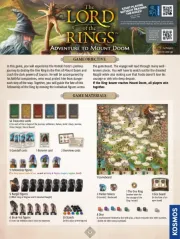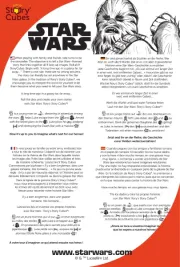Thames & Kosmos Cities: Skylines Handleiding
Thames & Kosmos
Bordspel
Cities: Skylines
Bekijk gratis de handleiding van Thames & Kosmos Cities: Skylines (8 pagina’s), behorend tot de categorie Bordspel. Deze gids werd als nuttig beoordeeld door 87 mensen en kreeg gemiddeld 5.0 sterren uit 44 reviews. Heb je een vraag over Thames & Kosmos Cities: Skylines of wil je andere gebruikers van dit product iets vragen? Stel een vraag
Pagina 1/8

1
GAME MATERIALS
Before the rst game, carefully separate all the die-cut pieces from their frames.
THE COOPERATIVE CITY-BUILDING GAME FOR URBAN PLANNERS AGES 10 AND UP
You have a big job ahead of you. Together, you want to build a new, thriving city where people are happy. To do that, you have a number of milestones
to complete. Each milestone represents a period of construction for your city. You will have to nish each milestone before beginning the next. Once
you have completed them all, the game ends. The quality and skill of your cooperative eorts will be reected in the happiness of your residents.
You can plan and consult among yourselves as much as you like. If you are not able to agree on something, it will be up to the active player to make the
nal decision. Just make sure that you don’t run out of money, or you will all lose the game together.
You learn the game by playing through various scenarios. The introductory game contains the important basic rules, but not all of the game elements.
In further scenarios, a variety of additional elements will come into play. The nal scenario involves the most variety and new challenges. If it’s your rst
time playing the game, you will want to play through the scenarios in the specied order.
If you want to start playing the game with all of the rules and elements, use Scenario 4 on page 7. Since the scenarios build on each other, you should
rst read these basic rules and additional rules of Scenarios 1–4. Then play Scenario 4.
Would you like the game
to be explained instead of
reading the rules? Then
download the free Kosmos
Helper App.
Download the Helper App
Learn to Play
6 Game board pieces (back sides A-F) 24 Residential zones 12 Commercial zones 12 Industrial zones
9 Utility buildings
18 Service buildings
10 Unique buildings
1 Starting player
token
30 Money tokens
1 Administration board
75 Construction cards
25 each, for Stages I, II, and III
Power Water Garbage 4x 5-unit
tokens
26x 1-unit tokens
8 Administration
markers
Healthcare Education Public
Transport
Fire Police Parks 2 Mounting feet
2 Happiness
indicators
1 “End of a Milestone”
overview card
4 Turn Overview
cards
1 Skyline (to display
overall Happiness)10 Unique
Building cards
10 Role
cards
10 Policies
cards
10 News
cards
The game materials that are needed in the introductory game should be placed back into the box: not
3 Game board pieces (C, D, F)
10 Unique building cards, 10 Role cards, 10 Policies cards, 10 News cards
10 Unique building tiles

AE
B
Give each player their own Turn Overview card.
2
Services Zones Utilities
Overview of Game Symbols
Healthcare
Education
Police
Fire
Public
Transport
Parks
Residential
Commercial
Industrial
Power
Water
Garbage
Pollution
Trac
Crime
Available
Labor
Happiness
Money
District
Milestone
GAME PREPARATION
Assemble the three game board pieces B, E, and A in the middle of the table
as shown below. The back sides with the letters should be facing up.
Note: In later games or if you want to play with all the rules right away,
assemble all four game boards as indicated for the given scenario.
Place the administration board face up next to the game boards and put the
eight administration markers on the matching display bars, on the “0” space
in each case.
Deposit a starting capital of 12 money tokens (two large money
with a value of ve and two small ones with a value of one) in the city
treasury. The rest of the money is placed in a stockpile next to the playing area.
Sort all the zone and building tiles in accordance with their color and type,
and keep them ready next to the playing area.
Shue the construction cards for Stage 1 and deal each player the
appropriate number of cards based on the total number of players
(see below). Each player places these cards in front of face up
himself or herself:
4 players: three cards each
3 players: four cards each
2 players: ve cards each
1 player: seven cards
Shue the remaining Stage I construction cards, as well as the Stage II and
Stage III ones, keeping the dierent stages separated. Have them ready next
to the playing area.
Place the Happiness display (Skyline) next to the
administration board. Stick the display chips onto the “0”
spaces of the numerical scales on the left and right sides of
the display.
The youngest player gets the Starting player token and the
“End of a Milestone” overview card. The starting player
token is “Chirper,” the mascot of Cities: Skylines.
The Administration Board
The administration board helps you keep track of how well your city is doing.
In the upper area, you can read the capacity of your city in the utility
categories of Power, Water, and Garbage. The farther into the green
range your marker is, the higher your capacity.
Important: For each step below “0” (red range), the Happiness of your
residents will drop by one at the End of a Milestone.
Happiness can take a positive, negative, or neutral (=0) value. After each
Milestone, this value is transferred to the overall Happiness display (Skyline).
The higher the overall Happiness at the end of play, the better your nal
result will turn out to be. You can see what this is by looking at the success
table on the nal page.
The employment bar displays the working population available to you.
Important: For each step away from “0” for your working population,
whether above or below, you will have to pay one money from the city
treasury at the end of a Milestone.
Background: The “0” value stands for full employment. If the value is below “0,”
the economy lacks a sucient labor force. If the value is above it, there is a
shortage of jobs. In either case, money must be invested.
In the lower area, you will see three bars that will have an impact on the
quality of life of your residents. Your construction activities will raise the
pollution, trac, and crime values during the game, but you can lower these
values by taking various countermeasures.
Important: At the end of the game, the overall Happiness of your residents
will drop in accordance with how far above “0” you are on these bars.
Crime
Employment bar
Power
Water
Garbage
Happiness
Pollution
Trac
Outcome at
the end of the
Milestone
Outcome at
the end of the
Milestone
City treasury

3
COURSE OF PLAY
Start of a Milestone
First, decide together which board game piece you want to start
with. You will want to take into consideration the development
costs printed on them. Once you have decided (the starting player has the
nal word!), take the required sum of money from the city treasury and
return it to the stockpile next to the playing area, turn the selected board
piece over, but keep it in the same position relative to the other pieces.
Note: You will have to rotate it around its longitudinal axis (formed by the row
of money tokens printed on it!). That way, the bodies of water shown on the
front side will be arranged the same as on the back.
Example: You pay two money tokens and turn game board piece A face-up.
On the front side of the board piece, you will see a
grid of squares, where you will be placing building
and zone tiles during the course of the game. The
tiles are not allowed to be placed over the edge of
the playing area, across streets, on other building
tiles, or on the water.
The squares are arranged into various areas. These are the districts of your
city. All areas that are bordered by a street or the edge of the board count as
City Districts.
Later on during the course of
play, a city district will be able
to extend over several game
board pieces. Many of the
cards refer to these districts.
Also, a condition for the end of a Milestone is that there be at least one
building or zone tile in each city district.
As the rst active player, the starting player carries out of the following one
three actions. Then, the next player in a clockwise direction becomes the
active player, etc.
The Actions:
Play a construction card
Exchange a construction card
End a Milestone
Play a Construction Card
There are two types of construction card:
For construction cards with service buildings or utility buildings on
them, you have to pay the amount of money indicated.
Example 1: You are building a medical clinic. You have to pay
one money and your Happiness increases by one.
Example 2: You are building a wind power plant. You have to
pay three money tokens and your Power capacity increases by
three. This means that you will soon be able to use more power.
The green, blue, and yellow construction cards are used to build
residential , commercial , and industrial zones.
These are free and require no money. Their impact on your city will vary in
terms of a number of factors, however. If you build them in such a way that
you use services, this will yield benets for your city. already-available
Example: You build a residential zone. The recently-arrived
residents consume more water. That causes your water capacity
to drop by one. But there is also a larger workforce available. The
value on your employment bar increases by one. If you utilize the
“healthcare” service indicated in the lower part of the card, you
get one money for your city treasury.
Important: This benet only applies if the service building is already
on the game board. If it is not built until later, the benet will not apply
retroactively.
If the player wants to play one of the construction cards lying in front of
himself or herself, he or she slides the card slightly forward.
The cards for and service utility buildings display the required tile on the
card. With the residential, commercial, and industrial cards, you can
take any tile you like from the matching zone category.
The player takes the tile from the and places it on a suitable general supply
location on the face-up game board. The player may turn and rotate it
however he or she likes to make it t best. The tile must t into the grid
of squares.
Once placed a constructed tile has to remain in place until the end of the
game. It cannot be moved again.
Important: In each city district, you are not allowed to construct
more than one utility building. If, say, you already have a wind turbine
in a district, you cannot also build an oil power plant there.
A water tower wouldn’t be possible there either.
For service buildings in the “Stage I” pile, the new zone (or at least
one square of it) has to be built to the service directly adjacent
building for this service building to be utilized.
Be sure to leave enough space to be able to build
more than one neighboring zone that can utilize
the service.
Example: Build the medical clinic in such a way
that there is room for several directly adjacent zones.
Product specificaties
| Merk: | Thames & Kosmos |
| Categorie: | Bordspel |
| Model: | Cities: Skylines |
| Kleur van het product: | Meerkleurig |
| Breedte: | 295 mm |
| Diepte: | 71 mm |
| Hoogte: | 295 mm |
| Aanbevolen leeftijd (min): | 10 jaar |
| Land van herkomst: | Duitsland |
| Voorgesteld geslacht: | Elk geslacht |
| Geschikt voor gebruik binnen: | Ja |
| Aanbevolen leeftijdscategorie: | Volwassene & kind |
| Minimum aantal spelers: | 1 |
| Type product: | Bordspel |
| Speeltijd (max): | 70 min |
| Maximum aantal spelers: | 4 |
| Genre: | Economische simulatie |
| Spelmodi: | Multiplayer, Single-player |
| Familiespel: | Ja |
| Niet-competitief spel: | Nee |
| Speeltijd (min): | 40 min |
| Naam game: | Cities: Skylines |
Heb je hulp nodig?
Als je hulp nodig hebt met Thames & Kosmos Cities: Skylines stel dan hieronder een vraag en andere gebruikers zullen je antwoorden
Handleiding Bordspel Thames & Kosmos

1 April 2025

1 April 2025
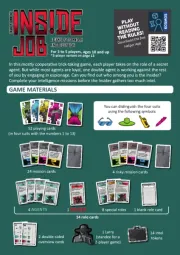
1 April 2025

1 Juli 2023

28 Juni 2023
Handleiding Bordspel
- Overig
- Philos
- MB
- Libellud
- Smart Games
- MindWare
- Games
- Ravensburger
- Blue Orange
- Gamewright
- Parker
- Stapelgekke Speed Cups
- Haba
- IMC Toys
- White Goblin Games
Nieuwste handleidingen voor Bordspel

3 Juli 2025
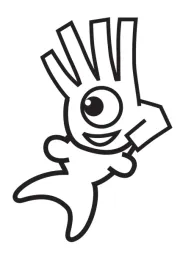
1 Juli 2025
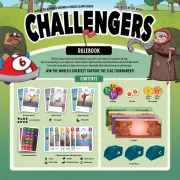
30 Juni 2025

19 April 2025

19 April 2025

19 April 2025

19 April 2025
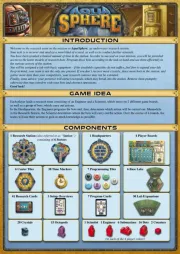
19 April 2025

6 April 2025
